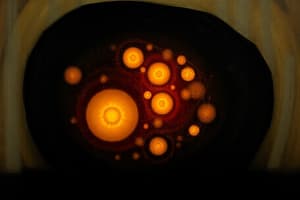Podcast
Questions and Answers
What is the main function of ribosomes in the cell?
What is the main function of ribosomes in the cell?
Ribosomes synthesize proteins by translating genetic information.
Describe the significance of chloroplasts in plant cells.
Describe the significance of chloroplasts in plant cells.
Chloroplasts are essential for photosynthesis, converting light energy into chemical energy.
What is the difference between bound and free ribosomes?
What is the difference between bound and free ribosomes?
Bound ribosomes produce proteins for export, while free ribosomes synthesize proteins that function within the cytosol.
What is the Endosymbiont theory in relation to chloroplasts?
What is the Endosymbiont theory in relation to chloroplasts?
What is the structure of thylakoids within chloroplasts?
What is the structure of thylakoids within chloroplasts?
Flashcards
Chloroplast Function
Chloroplast Function
Chloroplasts are organelles in plant cells that perform photosynthesis, converting light energy into chemical energy in the form of sugars.
Ribosome Structure
Ribosome Structure
Ribosomes are complex structures made of ribosomal RNA (rRNA) and proteins. Exist in two sizes, 70S in prokaryotes and 80S in eukaryotes (with different rRNA subunit components).
Bound Ribosomes
Bound Ribosomes
Ribosomes attached to the endoplasmic reticulum (ER); produce proteins destined for export or use within membranes.
Free Ribosomes
Free Ribosomes
Signup and view all the flashcards
Chloroplast Location
Chloroplast Location
Signup and view all the flashcards
Study Notes
Mitochondria and Chloroplasts
- Mitochondria and chloroplasts are double-walled organelles.
- They possess their own DNA and ribosomes.
- They can reproduce independently within a cell.
- Primitive eukaryotic cells engulfed aerobic, nonphotosynthetic prokaryotic cells.
- This symbiotic relationship evolved into modern eukaryotic cells.
Ribosomes
- Ribosomes are protein factories.
- They use genetic information from Ribosomal RNA and proteins to synthesize proteins.
- They were observed as dense particles in electron micrographs in 1953.
- Ribosomes are not membrane-bound.
- Prokaryotic ribosomes are 70S type. They contain a 30S and a 50S subunit.
- Eukaryotic ribosomes are 80S type. They consist of a 40S and a 60S subunit.
- Bound ribosomes produce proteins that are transported outside the cell.
- Free ribosomes are found in the cytoplasm and form chains called polyribosomes involved in protein synthesis.
Chloroplasts
- Chloroplasts contain chlorophyll and other enzymes for photosynthesis.
- They can have various shapes (lens-shaped, oval, spherical, discoid, or ribbon-like).
- Chloroplasts are found mainly in the mesophyll of plant leaves.
- A single large chloroplast or multiple chloroplasts (20-40) may be present per cell.
- Plant cells, algae, and some protists contain chloroplasts.
Chromoplasts
- They contain pigments like carotene and xanthophyll.
- These pigments impart red, yellow, or orange colors to flowers and fruits.
- Leucoplasts and amyloplasts do not have photosynthetic function-like chloroplasts.
Studying That Suits You
Use AI to generate personalized quizzes and flashcards to suit your learning preferences.
Description
Explore the fascinating world of organelles with a focus on mitochondria, chloroplasts, and ribosomes. This quiz delves into their structures, functions, and the critical roles they play in eukaryotic cells. Test your knowledge and understanding of these essential cellular components!




